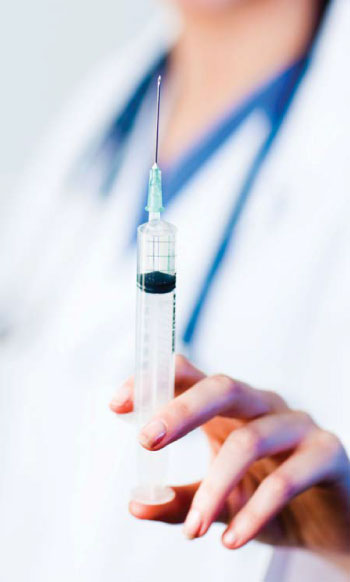Pneumococcal infection is associated with a wide range of diseases caused by the bacterium Streptococcus pneumoniae or in short, pneumococcus. The bacteria can be transmitted via spread of droplets, direct oral contact or indirect contact with surfaces soiled with respiratory discharge.
Pneumococcus is not only a common cause of mild illnesses such as sinus or middle ear infections, but also severe or even life-threatening invasive* pneumococcal diseases (IPD) such as pneumonia, sepsis, and meningitis. The effects of IPD are usually more severe among young children and elderly persons.
*‘Invasive’ disease means that germs invade parts of the body that are normally free from germs (e.g. bloodstream, tissue around the brain and spinal cord).
How prevalent is pneumococcal disease?
The World Health Organisation (WHO) estimates between 3.4 – 6.8% of the 8.8 million global deaths of children < 5 years of age in 2008 were attributable to pneumococcal infection.
In Malaysia, the prevalence of pneumonia in children under five is between 28% and 39%. It is the sixth main cause of death in Malaysia, with 5% of deaths in 2010 attributed to it.
How is pneumococcal infection treated?
Usually, infection is treated using antibiotic(s). However, increasingly, bacteria have slowly evolved to become resistant to antibiotics. Pneumococcal infections that are resistant to these antibiotics require treatment using more expensive antibiotics – this is why prevention of pneumococcal infections is important. The unnecessary overuse of antibiotics has also led to increased resistance.
How can IPD be prevented?
The best way to prevent infection is through vaccination. Nevertheless, everyday lifestyle practices are important as well such as maintaining good hygiene, avoiding bad habits (e.g. smoking), adequate rest, eating a balanced diet and being physically active.
What pneumococcal vaccines are available?
The first pneumococcal vaccine, licensed in 1977, was a polysaccharide vaccine (PPSV). It contained antigens* from 14 different types of pneumococcal bacteria. In 1983, a 23-valent polysaccharide vaccine was licensed and effectively replaced the 14-valent vaccine.
*Antigens are invaders in your body that causes your immune system to produce antibodies to fight against them.
Subsequently, the first Pneumococcal Conjugate Vaccine (PCV) licensed for use was in 2000 and contained seven serotypes (4, 6B, 9V, 14, 18C, 19F, and 23F) of S. pneumoniae and was named PCV7. In 2008 PCV10 was introduced and contained all the serotypes in PCV 7 (4, 6B, 9V, 14, 18C, 19F, 23F) plus serotypes:(1,5,7F). This was followed by the licensing of PCV13 in 2010 which added 3 new serotypes (3, 6A, and 19A) on top of the existing 10. Together, these 13 serotypes account for the majority of invasive pneumococcal diseases (IPD).
Today, three types of pneumococcal vaccines are used routinely:
- PCV10
- PCV13
- PPSV23
Is the vaccine effective?
PCV is 77 to 94% efficacious against pneumococcal serotypes, in many populations of healthy children. Studies show that at least 1 dose of PCV13 protects:
- at least 8 out of 10 babies from IPD
- 75 out of 100 adults 65 years or older against IPD
- 45 out of 100 adults 65 years or older against pneumonia
Meanwhile, studies of PPSV23 shows that it protects between 50 to 85 out of 100 healthy adults against IPD. However, PPSV23 does not prevent carriers of the virus from transferring the disease and cannot be given to children less than 2 years.
PCV13 is effective against both IPD and non-invasive pneumococcal infections and have a better efficacy against non-invasive pneumococcal infections when compared with PPSV23. Nevertheless, PPSV23 contains 12 of the serotypes included in PCV13, plus 11 additional serotypes and theoretically offers a wider range of protection.
Is the vaccine safe?
Pneumococcal vaccines have been demonstrated to be safe and severe adverse reactions attributable to the vaccine are extremely rare. However, like most medicines, there are a few mild side-effects (reported by 10-20% of children receiving the vaccine) which include slight swelling and redness at the injection site shortly following injection. Local reactions are more severe (e.g. soreness that interferes with arm or leg movement) following a second dose but most resolve within a few days without treatment.
How many pneumococcal serotypes are there?
Over 90, and previous infection of one serotype of pneumococcus may not confer immunity to other serotypes. However, only less than 20% are the major cause of disease.
Who should take the vaccine?
Children under 2 years should receive a standard regimen of three PCV13 doses at 2, 4 and 6 months and a booster dose at 12-15 months. Elders 65 years (without any high-risk conditions) and older as well as high-risk individuals aged >2 years should receive a single dose of PCV13, followed by a single dose of PPSV23 a year later.
What if my child misses a dose or gets behind schedule?
Just make sure they get the next dose as soon as possible.
What are considered high-risk conditions for acquiring pneumococcal disease?
- Has a history of previous IPD.
- Immunocompromised states:
- Abnormal spleen function (Asplenia), HIV /AIDS, primary immunodeficiency
- Immunodeficiency related to cancer and organ transplant.
- Immunodeficiency related to use of drugs/systemic steroids that suppress or reduces the strength of the body’s immune system.
- Chronic disease
- Chronic cardiac, pulmonary, liver or kidney disease
- Diabetes mellitus or cerebral spinal fluid leakage
- Thalassemia
- With cochlear implants
Where should I go to get vaccinated?
Unfortunately, PCV13 is not included in the list of vaccines subsidised under the National Immunisation Programme. However, it is an optional vaccine which is highly recommended and is available at private clinics nationwide. Talk to your doctor about pneumococcal vaccination today.
An educational contribution by Malaysian Paediatric Association







Comments